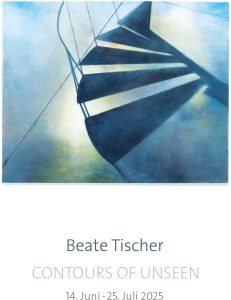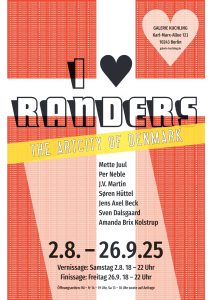BEATE TISCHER
„CONTOURS OF UNSEEN” 14th 06. – 25th 07. 2025
Finissage: Fr, 25th 07., 6-10 pm
We can look forward to a little musical surprise at the Finissage
Burkhard Stangl & Kai Fagaschinski
CONTOURS OF THE UNHEARD, ca. 30′
for Beate Tischer
Burkhard Stangl: Electric guitar
Kai Fagaschinski: Clarinet
The compositions of Austrian guitarist Burkhard Stangl and German clarinetist Kai Fagaschinski arrive at a stunning nexus of pretty lyricism and pure abstraction (Downbeat, Chicago)

With great pleasure, Galerie Kuchling presents the latest works by Beate Tischer – a painterly exploration of architectural space, perception, and stillness. Her paintings captivate with a striking balance between structural clarity and emotional depth.
In Tischer’s images, architecture appears not as backdrop, but as living structure, as a movement of light, as an invitation to see. She creates spaces where memory and imagination intersect – spaces that don’t explain, but invite sensation. We warmly welcome you to linger within this unique visual world and to discover new perspectives on space, light, and form.
Beate Tischer lives and works in Berlin. Her artistic path began with a degree in printing technology at TU Chemnitz. This was followed by studies at the Dresden University of Fine Arts and the Hochschule Niederrhein in Krefeld, where she studied painting and free ceramics. Her education was enriched by postgraduate work in multimedia design and hands-on experience in ceramic and puppet design studios. This wide-ranging background informs her precise yet poetic approach to space, form, and surface.
Her paintings invent, question, and traverse space. Architecture is never merely a subject, but a point of departure for a multilayered inquiry into surface, depth, light, and shadow. Solid staircases, walls, passages, and angles appear in carefully balanced compositions. Yet what at first seems stable begins to dissolve upon closer viewing: lines tilt, planes hover, perspectives shift and soften.
These paintings open spaces that are neither fully inside nor outside. They are in-between spaces – quiet, detached, almost meditative. The images feel like moments of still movement, like frozen trajectories of light and gaze. Light doesn’t simply fall upon surfaces – it passes through them, reflects, bends, returns. Shadows are not empty but active participants in the image, creating volume and subverting orientation.
A distinct feeling arises while viewing: a deep stillness that is not empty – but charged, breathing, alert. It feels like entering a room that’s waiting for someone. Like standing at a threshold between memory and possibility. What Beate Tischer paints is not an image of architecture, but spaces made of perception, thought, and rhythm. Her works echo a moment – familiar yet elusive. They don’t tell stories, but resonate in tensions and reverberations.
These are works that are quiet and intense at once. They ask for no interpretation, only presence – an invitation to look, to linger, to think further. And perhaps to sense what lies just beyond the visible.
Text: Josephine Müller
We look forward to your visit <3

Beate Tischer, PURE SPACES OR THE MASTERS’ HOUSES _04, oil on canvas, 2019, 81x51cm
Upcoming Exhibition
I L O V E R A N D E R S
Art City of Denmark
02nd August – 26th September
Amanda Brix Kolstrup – Jens Axel Beck – J.V. Martin – Mette Juul – Per Neble
Søren Hüttel – Sven Dalsgaard

7 Positions from the Homeland of Possibilities
What do gold-painted toy ships, Las Vegas nostalgia, a high-gloss handkerchief moment, and the poetic anatomy of a vulnerable body have in common? They all lead—directly or indirectly—to Randers. Not all artists in this exhibition were born here, yet Randers exerts a magnetic pull: a place where artistic currents meet, cross, and transform—simply put, the Art City of Denmark.

Søren Hüttel, Bauhaus, 120x195cm, acrylic and oil on canvas, 2021.
The exhibition I LOVE RANDERS brings together works by Amanda Brix Kolstrup, Jens Axel Beck, J.V. Martin, Mette Juul, Per Neble, Søren Hüttel and Sven Dalsgaard. What connects them is a shared place of origin; what sets them apart are artistic directions as diverse as the rivers surrounding the city—at times meandering, at times eruptive.
Amanda Brix Kolstrup poses quiet yet fearless questions: What does illness do to a body, to a gaze, to art itself? Her works are intimate, performative reflections on fragility and resilience—tactile anatomies of being.
Jens Axel Beck combines painting, ceramics, discarded materials, and digital media into ensembles that bring everyday spaces and objects into a fragile balance. The result is images of a present oscillating between transience, restlessness, and the need for meaning.
J.V. Martin, the situationist in a golden coat, set sail with an armada of lacquered toy ships and steered into revolutionary theory. His “New Irrealism” bursts through form, color, and meaning—always collaging, acting, and disrupting.
Mette Juulturns her gaze to the quiet, familiar people of small-town America — capturing the way their eyes meet hers as she watches them. Her photographs unfold gentle portraits of everyday life, laced with a delicate, almost floating tension between observer and observed.
Per Neble, on the other hand, was the court jester among conceptual artists — earnest in his wit, provocative in his openness. His installations are never straightforward but reveal a humor that neither ingratiates nor flatters.
Meanwhile, Søren Hüttel dives into pop-cultural references like a glitter-soaked whirlpool: Las Vegas meets Star Trek, meets the structural void. His works are visual mixtapes, lit with disco shimmer.
And Sven Dalsgaard, who once taught himself to paint, left behind naturalism in favor of abstract visual languages and towering sculptures that continued to grow in his paintings. Surrealism, minimalism, Jesus from Randers — all in one body of work.
Seven artists, seven trajectories, one place: Randers – the Art City of Demark. This exhibition isn’t a declaration of love. It’s a proof of love.
Text: Josephine Müller

Amanda Brix Kolstrup, Suspended foundation concrete, Styrofoam, reinforcing bars, lines, wood and ropes, 220 cm x 120 cm x 60 cm, 2022.

